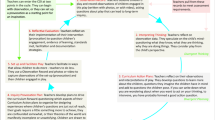Abstract
This study examines children's choice of drawing to communicate their understanding of the concept “technology”. The study explored whether the children's drawings accurately reflected the depth and range of their understanding of technology in a way that was interpretable by others. Data were collected from 314 primary school children in England and 745 children in Western Australia. Children were invited to demonstrate their knowledge and understanding about technology by responding to a writing/drawing activity and a representative subsample were then interviewed about their responses. About two-thirds of children's responses to the activity included drawings. Children held a wide range of ideas about technology and only rarely was a drawing difficult to interpret. Although overall the drawings reflected the range of children's ideas, sometimes they did not reveal the depth or breadth of an individual child's understanding. Consistent with the ideas represented in the drawings, the interviews found that younger children held simpler ideas about technology, while older children held more complex, and sometimes quite abstract concepts of technology. A notable difference between the two countries was the emphasis on “design and make” and a smaller proportion of no response in the English sample, reflecting the greater length of time technology education has been implemented in England compared to Western Australia.
Similar content being viewed by others
References
Ault, C. Jr. (1993). Technology as method-of-enquiry and six other (less valuable) ways to think about integrating technology and science in elementary education.Journal of Science Teacher Education, 4, 58–63.
Barrett, M. D., & Light, P. H. (1976). Symbolism and intellectural realism in children's drawings.British Journal of Educational Psychology, 46, 198–202.
Bird, J., & Diamond, D. (1978).Teaching primary science: Candles. London: Macdonald Educational.
Cox, M. V. (1993).Children's drawings of the human figure. Hove: Lawrence Erlbaum Associates.
Curriculum Corporation. (1993).A National Statement on Technology for Australian schools. Carlton, Victoria, Australia: Curriculum Corporation.
de Klerk Wolters, F. (1989).The attitudes of pupils towards technology. Unpublished doctoral thesis at the University of Technology Eindhoven, The Netherlands.
Di Leo, J. H. (1980). Graphic activity of young children: Development and creativity. In: L. Lasky & R. Mukerji (Eds.),Art: Basic for young children, Washington, DC: National Association for the Education of Young Children.
Department of Education. (1992).Technology for ages 5 to 16. London: Department of Education and the Welsh Office.
Gainer, R. S., & Child, J. S. (1986). Scientific illustration in the elementary school.Art Education, November, 19–22.
Gardner, P. L. (1990). The technology-science relationship: Some curriculum implications.Research in Science Education, 20, 124–133.
Gardner, P. L. (1993). Textbook representations of science-technology relationships.Research in Science Education, 23, 85–94.
Gardner, P. L. (1994). The relationship between technology and science: Some historical and philosophical reflections. Part I.International Journal of Technology and Design Education, 4, 123–153.
Gardner, P. L. (1995). The relationship between technology and science: Some historical and philosophical reflections. Part II.International Journal of Technology and Design Education, 5, 1–33.
Gardner, P. L., Penna, C., & Brass, K. (1989). Technology and science: Meanings and educational implications.The Australian Science Teachers Journal, 36(3), 22–28.
Harris, D. (1963).Children's drawings as measures of intellectual maturity. New York: Harcourt, Brace & World.
Hayes, D., & Symington, D. (1984). The satisfaction of young children with their representational drawings of natural phenomena.Research in Science Education, 14, 39–46.
Hayes, D., Symington, D., & Martin, M. (1994). Drawing during science activity in the primary school.International Journal of Science Education, 16, 265–277.
Hulland, C., & Munby, H. (1994). Science, stories, and sense-making: A comparison of qualitative data from a Wetlands Unit.Science Education, 78, 117–136.
Jarvis, T., & Rennie, L. J. (in press). Understanding technology: The development of a concept.International Journal of Science Education.
Krampen, M. (1991).Children's drawing: Iconic coding of the environment. New York: Plenum Press.
Kutnick, P. (1978). Children's drawings of their classrooms: Development and social maturity.Child Study Journal, 8, 175–186.
Lasky, L., & Mukerji, R. (1980).Art: Basic for young children. Washington, DC: National Association for the Education of Young Children.
Layton, D. (1993).Technology's challenge to science education, Buckingham: Open University Press.
McGuigan, L., Qualter, A., & Schilling, M. (1993). Children, science and learning.Investigating 9(4), 23–25.
Melzi, K. (1967).Art in the primary school, Oxford: Basil Blackwell.
Moore, J. (1987). A technique for discovering young pupils' ideas about technology.CASTME Journal, 7(1), 1–9.
Osborne, R., & Gilbert, J. A. (1980). A method for the investigation of concept understanding in science.European Journal of Science Education, 2, 311–321.
Qualter, A., Schilling, M., McGuigan, L. (1994). Exploring children's ideas.Investigating, 10(1), 21–24.
Raat, J. H., & de Vries, M. (1987). Technology in education: Research and development in the project ‘Physics and Technology’.International Journal of Science Education, 9, 159–168.
Rennie, L. J., & Jarvis, T. (1995). Three approaches to measuring children's perceptions about technology.International Journal of Science Education, 17(6), 755–774.
Rennie, L. J., & Jarvis, T. (1994).Helping children understand technology. Perth, Western Australia: The Key Centre for School Science and Mathematics, Curtin University of Technology in association with the Science and Technology Awareness Program, Department of Industry, Science and Technology.
Rennie, L. J., & Jarvis, T. (1995). English and Australian children's perceptions about technology.Research in Science & Technology Education, 13, 37–52.
Rosch, E. (1978). Principles of categorisation. In E. Rosch & B. Lloyd (Eds.),Cognition and categorisation. Hillsdale, NJ: Erlbaum.
Schilling, M., McGuigan, L., & Qualter, A. (1993). The Primary Science and Concept Exploration (SPACE) Project.Investigating, 9(3), 27–29.
Symington, D., & Hayes, D. (1991). Drawing for a purpose.Australian Journal of Early Childhood, 19(3), 38–40.
Symington, D., Boundy, K., Radford, T., & Walton, J. (1981). Children's drawings of natural phenomena.Research in Science Education, 11, 44–51.
Taylor, R., & Andrews, G. (1993).The arts in the primary school. London: Falmer.
Weigand, H. (1985). From Science into art.Art Education, November, 18–21.
Author information
Authors and Affiliations
Corresponding author
Rights and permissions
About this article
Cite this article
Rennie, L.J., Jarvis, T. Children's choice of drawings to communicate their ideas about technology. Research in Science Education 25, 239–252 (1995). https://doi.org/10.1007/BF02357399
Issue Date:
DOI: https://doi.org/10.1007/BF02357399




